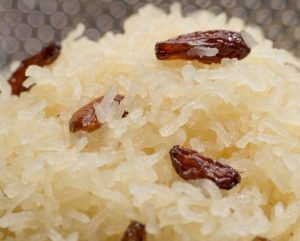 Sitabhog, a delectable traditional sweet from the historic city of Bardhaman, West Bengal, is a culinary masterpiece that has been delighting sweet lovers for generations. This unique confection is made from a blend of Gobindo Bhog rice flour and Chhena (fresh soft cottage cheese), combined with fresh ghee to form a soft, pliable dough. The dough is then carefully passed through a sev mould, transforming it into delicate, thin threads of vermicelli that resemble fine white rice. Once prepared, these threads are deep fried in pure ghee until they reach a perfect golden hue.
Sitabhog, a delectable traditional sweet from the historic city of Bardhaman, West Bengal, is a culinary masterpiece that has been delighting sweet lovers for generations. This unique confection is made from a blend of Gobindo Bhog rice flour and Chhena (fresh soft cottage cheese), combined with fresh ghee to form a soft, pliable dough. The dough is then carefully passed through a sev mould, transforming it into delicate, thin threads of vermicelli that resemble fine white rice. Once prepared, these threads are deep fried in pure ghee until they reach a perfect golden hue.
The story of Sitabhog is deeply tied to the cultural and historical identity of Bardhaman, which derives its name from Mahavira or Vardhaman Swami, a significant figure from around the 6th century BCE. While Bardhaman is famed for several traditional sweets, such as Langcha and Mihidana, Sitabhog holds a special place in the hearts of locals and visitors alike. The sweet even received the prestigious Geographical Indication (GI) Tag in 2017, further solidifying its importance in the rich tapestry of Bengali culinary heritage.
Though some say that Sitabhog was one of the favorite sweets of Sita Mata, little historical documentation exists to confirm this. However, its name and legend continue to evoke curiosity and charm.The process of making Sitabhog is as intricate as it is fascinating. After the vermicelli-like threads are fried to perfection, they are immersed in a freshly prepared sugar syrup infused with Tejpat (Bay leaves), adding a subtle, aromatic flavor. The threads are left to soak until they absorb just the right amount of sweetness, becoming soft yet maintaining their delicate form.
But Sitabhog’s allure doesn’t end there. The sweet is also accompanied by tiny, dark-brown Nikhuti—small, oval-shaped dumplings made from Gobindo Bhog rice flour, milk powder, and ghee. These dumplings are deep-fried in ghee until they achieve a rich, dark color and are then dipped in concentrated sugar syrup, allowing them to soak in the syrupy goodness before being mixed with the soft vermicelli threads. The combination of the two creates a delightful contrast of textures and flavors—smooth, sugary vermicelli paired with chewy, sweet Nikhuti.
To enhance both the taste and appearance of Sitabhog, fried cashew nuts and kismis (raisins) are added, making the dish more visually appealing and adding an extra layer of richness to every bite. The result is a sweet that not only melts in your mouth but also offers a variety of textures and flavors, from the buttery cashews to the syrupy Nikhuti and the ghee-infused vermicelli.
Today, almost every sweet shop in Bardhaman proudly serves high-quality Sitabhog alongside other traditional Bengali sweets. Its exquisite taste, combined with the city’s deep-rooted culinary traditions, has made Sitabhog a beloved delicacy across Bengal and beyond. Whether enjoyed during festivals, celebrations, or simply as a treat for yourself, Sitabhog continues to stand as a symbol of Bardhaman’s rich heritage and the artistry of its sweet makers.
This unique sweet, with its perfect blend of ingredients and flavors, is not just a dessert—it’s a celebration of history, culture, and tradition. With its GI tag, Sitabhog’s legacy is now protected, ensuring that future generations can continue to enjoy the taste of Bardhaman’s rich culinary past.






